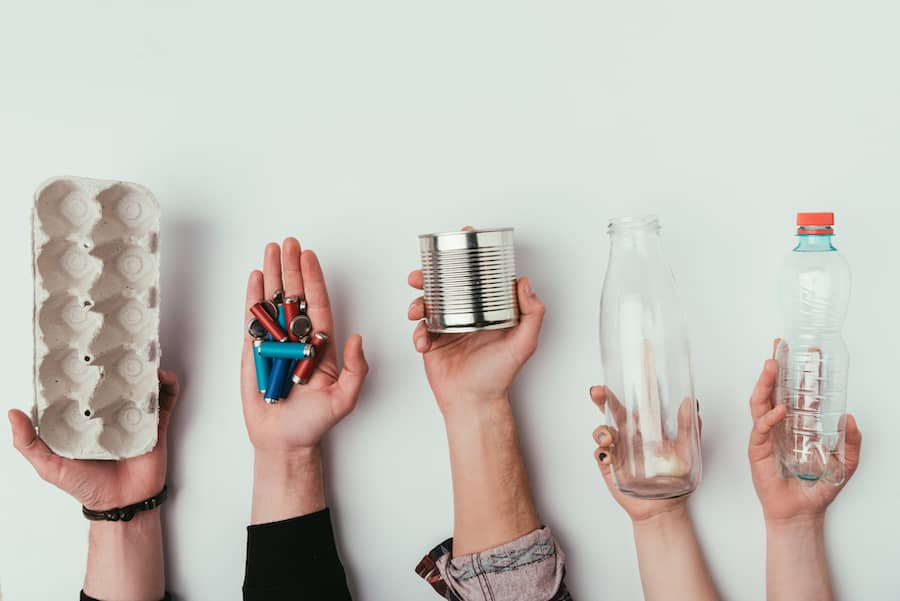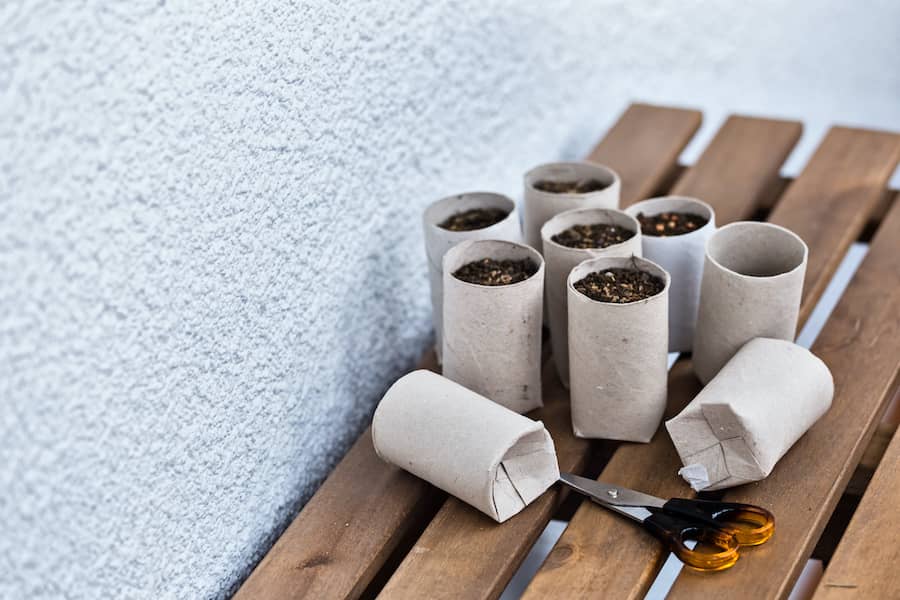Recycling vs Upcycling: Processes and Materials
The negative impact of waste material on the environment as in pollution, climate change and damaged ecosystems, is a grave concern of the international community today. Appropriately, there has been a gradual shift from a linear economy of “take, make, dispose” to a circular one of “make, use, recycle.” Private and governmental policies are getting more stringent and more thorough in many countries, and the manufacturing industry is continuously adapting to operate within these guidelines.
Reducing the impact of waste materials and their by-products (such as greenhouse emissions, air and water pollutants, and nuclear waste) on the environment is of utmost importance. Reusing waste materials in a manner that consumes less energy than that needed to manufacture such materials from scratch can be the way forward. This can be done either via recycling or upcycling.
Recycling refers to the breakdown and reuse of waste as raw materials to make new products. On the other hand, upcycling, a term coined in 1994 by Reiner Pilz [1], involves reusing waste materials in their current state without the need to break them down into their base state. Naturally, this process consumes less energy than traditional recycling, although it poses its own specific challenges.
In this article, you will learn about:
- What recycling is
- What upcycling is
- Comparison of the recycling and upcycling processes
- Common materials that can be recycled or upcycled
What is recycling?
Recycling is the process of breaking down waste materials into new raw materials to create new products.

A material that can be easily recycled is said to have high recyclability, which also means its material properties do not show significant depreciation from those of the virgin material.
The goal of recycling is one that has been revisited many times in the past. Most recently, the 3R model of Reduce, Reuse, and Recycle has taken up speed. Production and consumption trends have increasingly adopted this model. Forty-four million tonnes of waste are estimated to have been generated worldwide in 2016, and of this amount, only a fifth were recycled [2]. This shows how much room for improvement there is within recycling.
Recycling has been more of a way to mitigate the environmental impact of waste rather than a way to eliminate it. For instance, energy recovery is an aspect of recycling that focuses on securing energy from waste materials by converting non-recyclable waste into thermal energy, electrical energy, or fuel. It makes up the bulk of recycling processes worldwide. Since it usually takes the form of incinerating waste materials, it may produce toxic emissions, an aspect that is strictly monitored, limited, and measured periodically.
The next biggest part of recycling is the actual recycling of materials for reuse. This is both an environmentally and economically motivated venture, as raw materials obtained directly from natural sources are getting increasingly harder to come by. A material such as aluminium, for example, is obtained more through secondary means of recycling rather than through primary sources from mining.
What is upcycling?
Upcycling is the process of reusing waste materials without breaking them down into their base state to create a product of higher value or quality.

The term upcycling is relatively new, but its concept is quite old, commonly described as creative reuse. Unlike recycling, upcycling does not aim merely to reuse waste materials but to reuse them in such a way that their intrinsic value or quality is enhanced.
Braungart and McDonough, who many consider as the pioneers of upcycling, emphasise the importance of planning for future upcycling during the design of products [3]. This principle is often referred to as designing out waste. Designing out waste can be achieved through several methods, such as designing for reuse/recovery, off-site construction, material optimisation, and waste-efficient procurement.
In relation to upcycling, designing out waste can be done by designing products that can be easily assembled or disassembled and can incorporate future expansions if required [4]. Specific measures should be taken to facilitate quicker and easier disassembly, repair, repurposing, and reuse of the products.
It is essential to evaluate materials’ environmental impact, and one of the most common methods to do that is through the Life Cycle Assessment (LCA). LCA is a cradle-to-grave analysis that helps determine the environmental impact at every point in the product’s life cycle, from sourcing its raw materials through manufacturing the product and culminating in the disposal at the end of its life cycle. There are standards that can guide product manufacturers in their manufacturing processes to incorporate recycling principles.
Some companies, like Sabic, have even begun to marry the two processes of recycling and upcycling to create new sustainable materials for production. By upcycling post-consumer recycled polyethylene terephthalate (rPET) into higher-value polybutylene terephthalate (PBT) compound resins, Sabic are able to enhance the material’s properties while extending the useful life of PET products and contributing to plastic waste reduction.
Lavergne is another company that marries recycling and upcycling. For example, they take PET-based products, such as bottles and single-use food packaging, and turn them into recycled PET. They can then also upcycle materials in their VYPET™ series into polyester compounds for enhanced reuse in the automotive industry, electrical and electronic components, and within appliances.

Factors considered in the Life Cycle Assessment [5]
What is the difference between recycling and upcycling?
The following table shows the difference between the two processes of recycling and upcycling, highlighting their merits, demerits and challenges in undertaking them [6].
|
RECYCLING |
UPCYCLING |
|
Recycling consumes a relatively large amount of energy in its process due to activities such as transportation, cleaning, sorting, melting, purification, granulation, and extruding. |
Upcycling consumes relatively little energy as the processes involved usually include only cleaning and assembly/disassembly of parts. |
|
Recycled products, like plastics, are usually of lower quality than products that use virgin materials due to contamination and inefficient separation. |
Upcycled products are usually of similar or higher quality than products that use virgin materials. |
|
An aspect of recycling is energy recovery which can produce toxic waste. |
Upcycling produces a significantly less amount of toxic waste. |
|
The process of recycling is relatively straightforward. |
The process of upcycling can be very complicated due to the extremely varied and dissimilar nature of the waste materials. |
|
Recycling can be applied to a broader range of materials such as plastics, metals and paper since waste materials can be broken down into simpler forms. |
Upcycling is limited in its scope of application since the waste materials have to be considered “as is” rather than as the materials they’re made out of. |
|
Recycling can be done on a large scale as it has an established infrastructure to collect, breakdown and reuse recycled materials. |
Upcycling is still in an underdeveloped stage and has a long way to go in terms of the supply chain, networking and bulk manufacture. |
|
Much of the process of recycling can be automated. |
Upcycling is difficult to automate because the new products are often unique. |
|
There is a readymade market for recycled products. |
Upcycled products are not as viable for commercial production as recycled products. |
Common materials that can be recycled or upcycled
Some materials are more amenable for recycling and upcycling than others. Among the most commonly recycled materials are:
- concrete
- metals (such as steel and aluminium)
- plastics (such as PET, PP, PBT, and PLA)
- textiles
- wood
- glass
- paper
The recyclability of one member of these groups of materials, compared to another member, can give it the crucial edge in material selection. Some “raw” materials can be obtained through proprietary methods of upcycling, and other materials are simply produced in a way that renders them relatively easy to recycle.
Brown paper bags are used as substitutes for plastic bags so that they can be recycled more easily. Plastic straws are being replaced with metal ones when possible as they can be reused multiple times and recycled easily at the end-of-life stage.
Some products, however, are difficult to recycle or upcycle due to the extremely specific nature of their design/application or the nature of the materials used to manufacture them. Foam polystyrene, for example, is difficult and uneconomic to recycle as it is composed mostly of air and often contaminated.
Recycling products that combine dissimilar materials is also challenging because they are difficult to separate. Plastics such as PET, HDPE and PVC are often easier to recycle as they usually serve as liquid containers or piping materials. Other plastics such as LDPE are often used as squeezable tubes and food packaging, which means they are often contaminated to the point that it would require more energy to recycle them than to produce them from scratch. The same goes for dual material products like glossy paperboard materials (used to make items like juice boxes), which prove difficult to separate into their individual constituents.
However, certain products that cannot be recycled can instead be upcycled, and vice versa. The foam polystyrene mentioned above (more commonly referred to as styrofoam) can be upcycled rather than recycled while copper tubings and wires can be recycled readily rather than upcycled.
The table below shows a list of polymer materials on Matmatch that are either recycled or upcycled.
|
Material name |
Material category |
Property |
| DuraSense Recycled S30 Black | Polypropylene (PP) | Recycled Polypropylene (PP) reinforced with 30% S-Wood fibre |
| VYPET™ VNT-102 HS | Polyethylene Terephthalate (PET) | Recycled PET - unfilled |
| Murdotec® 1000 U black AST | Ultra High Molecular Weight Polyethylene (PE-UHMW) | Recycled |
| LDPE GM-LD H | Low-Density Polyethylene (PE-LD) | Recycled PE grade |
| PBT black HAKAdur | Polybutylene Terephthalate (PBT) |
Recycled |
| ALFACOM® 40CRL | Polypropylene (PP) | 100% recycled glass-fibre-reinforced PP |
| LNP™ ELCRIN™ WF006JiQ | Polybutylene Terephthalate (PBT) | Upcycled, 30% glass filled iQ PBT grade (37% PCR weight content) |
| LNP™ ELCRIN™ 61000IiQ | Polymer Blend | Upcycled, reinforced, impact modified PBT+PC alloy (22% PCR weight content) |
| LNP™ ELCRIN™ 6K002XiQ | Polymer Blend | Upcycled, mineral-filled alloy of iQ PBT/PC resin (18% PCR weight content) |
| LNP™ ELCRIN™ W10001iQ | Polybutylene Terephthalate (PBT) | Upcycled, unreinforced, non-chlorinated/brominated PBT grade (44% PCR weight content) |
Sources
[1] Xu, Jiang, and Ping Gu. "Five principles of waste product redesign under the upcycling concept." 2015 International Forum on Energy, Environment Science and Materials. Atlantis Press, 2015.
[2] Calvo, Sara, et al. "Addressing Sustainable Social Change for All: Upcycled-Based Social Creative Businesses for the Transformation of Socio-Technical Regimes." International Journal of Environmental Research and Public Health 17.7 (2020): 2527.
[3] McDonough, William, and Michael Braungart. "Remaking the way we make things: Cradle to cradle." New York: North Point Press. ISBN 1224942886 (2002): 104.
[4] Plan, Waste Resource Action. "Designing Out Waste. A design team guide for civil engineering. Part 1, Design Guide." Institute of Civil Engineers (2012).
[5] Oyenuga, Abioye A., Rao Bhamidimarri, and P. D. Researcher. "Upcycling ideas for sustainable construction and demolition waste management: Challenges, opportunities and boundaries." International Journal of Innovative Research in Science, Engineering and Technology 6.3 (2017).
[6] Sung, Kyungeun, and Kyungeun Sung. "A review on upcycling: Current body of literature, knowledge gaps and a way forward." World Academy of Science, Engineering and Technology, 2015.
